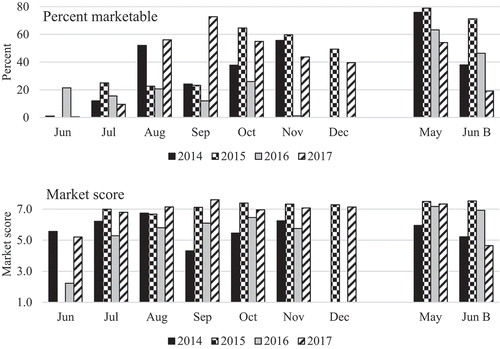Figures & data
Figure 1. Percentage transmittance of radiation through clear plastic films used to cover low tunnels for strawberry production. Transmittance through the plastic film was measured with an integrating sphere coupled with a single-mode fiber optic probe to a spectroradiometer across the 350 to 2500 nm wavelength range at 1 nm intervals. Films used were TempCool™ 0.102 mm thick film (TC film) (Berry Plastic Corporation, Greenville, SC), Clear TIII 0.102 mm thick film (“standard clear” or SC film), TIII TES/IR 0.102 mm thick film (TES film) (Berry Plastic Corporation, Greenville, SC), and Kool Lite Plus 0.152 mm thick Poly film (KL film) (Klerks Hyplast Inc., Chester, SC)
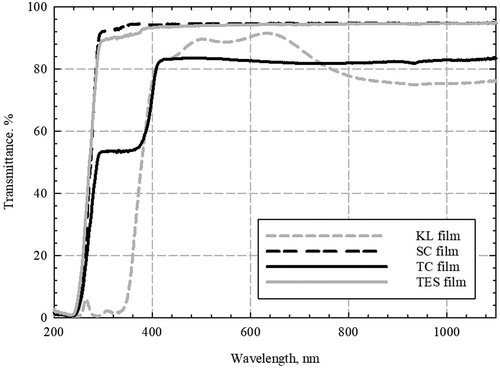
Table 1. Strawberry cultivars compared using analyses of variance and simple average performance relevant to overall cultivar mean performance. Statistically significant differences between cultivar trait means within a year are designated by lower-case letters. Above-average cultivar trait means within and across years are designated with bold text and a grayed field. An index for cultivar performance across all traits used average performance across years to identify “above average” cultivars. Above-average means were given a value of “1” and summed across traits and tests to identify cultivars that performed above average for multiple traits and test years
Figure 2a. Monthly yield, percent rotted yield, berry weight, percent marketable yield, and market score from strawberries grown under low tunnels. Work was done in five years through four test plantings (2014, 2015, 2016, 2017). Each test was harvested from June or July of the year of planting through November or December, and then again the following April or May through June
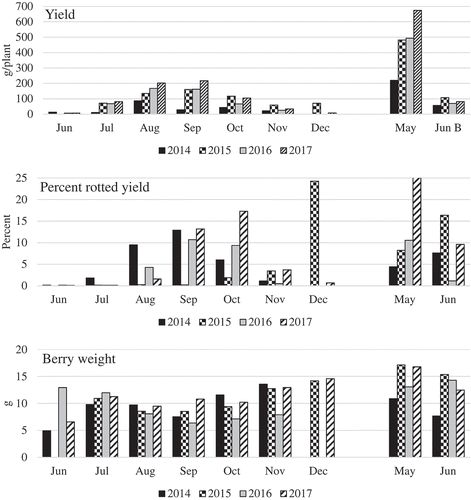
Figure 3. Yield from six strawberry cultivars grown under low tunnels. Work was done in five years through four test plantings (2014, 2015, 2016, 2017). Each test was harvested from June or July of the year of planting through November or December, and then again the following April or May through June. Cultivar yields were averaged across all four tests for each month, then monthly harvests were totaled for the months in the year of planting, and totaled separately for the months following the year of planting. Film yields were averaged within test then totaled. Films tested were TempCool™ 0.102 mm thick film (TC film) (Berry Plastic Corporation, Greenville, SC), Clear TIII 0.102 mm thick film (“standard clear” or SC film), TIII TES/IR 0.102 mm thick film (TES film) (Berry Plastic Corporation, Greenville, SC), and Kool Lite Plus 0.152 mm thick Poly film (KL film) (Klerks Hyplast Inc., Chester, SC)
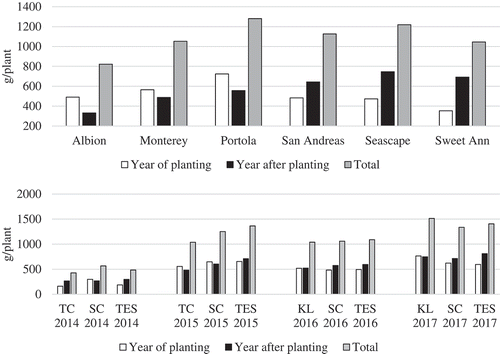
Table 2. Performance of repeat-fruiting strawberry cultivars when grown in low tunnels covered with different films. Statistically significant differences between film means of cultivar performance under each film, by trait each year, are designated by lower-case letters. Above-average trait means of specific cultivars under specific films, within and across years, are designated with bold text and a grayed field. An index of performance of each cultivar under each film, across all traits, used counts of above-average performance. Above-average cultivar-by-film interaction means were given a value of “1” and summed across traits and tests to identify cultivar-by-film combinations that performed above average for multiple traits and test years
Figure 4. Total yield per month of repeat-fruiting strawberries when grown in low tunnels covered with different films. Statistically significant differences between film means each month, are designated by lower-case letters for each trait. Four tests were established, one test in each of four years (2014, 2015, 2016, and 2017). All four tests compared Clear TIII 0.102 mm thick polyethylene film (“standard clear” or SC film) and TIII TES/IR 0.102 mm thick polyethylene film (TES film) (Berry Plastic Corporation, Greenville, SC). The first two tests (2014 and 2015) also included TempCool™ 0.102 mm thick polyethylene film (TC film) (Berry Plastic Corporation, Greenville, SC). The second two tests (2016 and 2017) also included Kool Lite Plus 0.152 mm thick polyethylene film (KL film) (Klerks Hyplast Inc., Chester, SC)
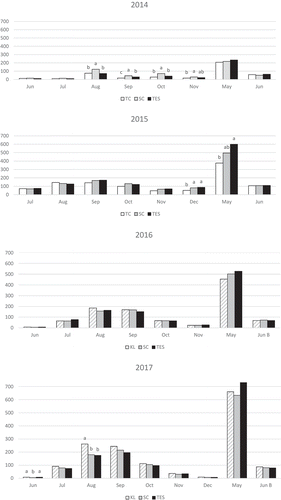
Table 3. Pearson’s pairwise correlation coefficients, calculated from plot averages, for yield (YLD), percent marketable yield (PM), percent rotted yield (PR), berry weight (BW), and market score (MS) of repeat-fruiting strawberries grown under low-tunnels. The number (n) of (x,y) data points used to calculate each correlation estimate, and the probability of the calculated estimate is not zero (test of null hypothesis)
Table 4. Plastic films covering low tunnels compared using analyses of variance and simple average performance relevant to overall mean performance under all films. Films used were TempCool™ 0.102 mm thick film (TC film) (Berry Plastic Corporation, Greenville, SC), Clear TIII 0.102 mm thick film (“standard clear” or SC film), TIII TES/IR 0.102 mm thick film (TES film) (Berry Plastic Corporation, Greenville, SC), and Kool Lite Plus 0.152 mm thick Poly film (KL film) (Klerks Hyplast Inc., Chester, SC). Statistically significant differences between film means by trait each year are designated by lower-case letters. Above-average trait means under films within and across years are designated with bold text and a grayed field. An index of performance under each film across all traits used average performance across years to identify “above average” performance under films. Above-average interaction means were given a value of “1” and summed across traits and tests to identify films that performed above average for multiple traits and test years

